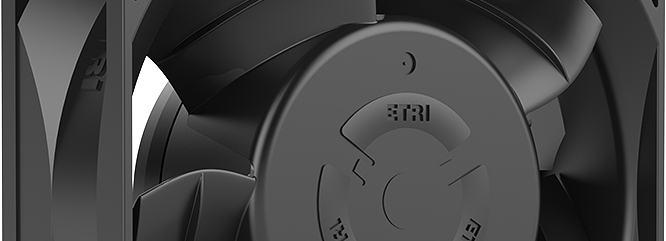EN 45545-2 Railway applications
Fire protection for rail vehicles
We are regularly consulted for axial or centrifugal fans conforming to HL2 - R22 or HL3 - R23, for example. These requirements are defined in EN 45545-2.
This is a European standard that defines the fire behavior requirements for materials used in rail vehicles (trains, metros, streetcars, etc.). It is part of the EN 45545 series, which deals with fire safety in rail transport. Part 2 focuses specifically on requirements for materials and components.
Main objective
The main aim of the standard is to reduce the risk of fire and limit the spread of fire, smoke and toxic gases in the event of a fire on board a train, in order to protect passengers and staff.
It also aims to ensure that, in the event of an on-board fire, passengers and on-board personnel can evacuate, and that the rail vehicle can reach a safe area.
Compliance with the standard minimizes the possibility of material ignition, and the effects of heat, smoke and toxic gases. All with the aim of evacuating the vehicle.
Requirements are defined according to
- risks levels (Hazard Level)
- products categories (Requirement)
Risks levels HL (Hazard Level)
Standard EN 45545 includes an HL requirement. This corresponds to the severity of the tests to be validated for the materials: HL1 the lightest, HL3 the most severe.
The vehicle operator determines whether he needs HL1, HL2 or HL3 products. This choice depends on the vehicle's operating area: type of line (surface, tunnels, distance and time between stops), vehicle speed and vehicle type: single-deck, double-deck, sleeper or automatic.
HL classification:
- HL1 : Low, Commuter trains, open areas, good evacuation
- HL2 : Medium, Intercity trains, moderate tunnel journeys
- HL3 : High, subways, TGV tunnels, underground areas, difficult evacuation
Let's take an example: it's easier to evacuate a surface tramway with no tunnels and no floors than a sleeper train crossing the Alps. That's why we'll ask for an HL1 for a tramway and an HL3 for a sleeper train.
The higher the HL level, the more stringent the requirements in terms of :
- Flame propagation
- Smoke generation
- Gas toxicity (CITN indices)
Each level of risk requires a test method, test conditions and reaction-to-fire performance requirements.
Product categories R (Requirement)
EN45545-2 provides elements for
- validate materials
- calculate the total mass of unapproved combustible materials accepted.
- getting new materials approved (what type of tests to carry out, etc.)
Our fans fall into the category of clippers and windings, i.e. R22 and R23. R22 is for indoor use and R23 for outdoor use.
| Product N° | Name | Details | Requirement |
| EL7A | Clippers and windings - Interiors | Clippers for power line filtering, windings for dry-type transformers, including spacers and air ducts | R22 |
| EL7B | Clippers and windings - Exteriors | Clippers for power line filtering, windings for dry-type transformers, including spacers and air ducts and traction motor winding insulation | R23 |
Products and families of materials not mentioned in the standard are to be considered as unlisted, or are to be tested and certified by accredited laboratories.
For non-listed products, exposed surfaces are taken into account when assessing requirements, as shown in the table below.
| Exposed surface | Location | Requirements shown in the table above |
| >0,20m² | interior | R1 |
| >0,20m² | exterior | R7 |
| ≤0,20m² | interior | R22 |
| ≤0,20m² | exterior | R23 |
If the exposed surface is greater than 0.2m², the requirement is R1 or R7
If the exposed surface is less than 0.2m², the requirement is R22 or R23 (as for our fans belonging to the EL7A and EL7B product families).
Assessment of conformity to the standard requirement
The more massive and combustible a material, the more it can aggravate a fire → so the stricter the requirements.
For each combination of R (Requirement) and HL (risk level), the standard defines the threshold values that materials must meet.
Products with a combustible mass of less than 10 g
No requirements apply to products with a combustible mass of less than 10 g, without direct contact with another unclassified product.
Products with a combustible mass of more than 10 g
Other products should be considered as grouped if :
- the exposed surface area of each product is less than 0.2 m2
- they do not comply with the applicable requirements of the above table.
- the combustible mass of each product is greater than 10 g or if they are in direct contact with another combustible product
- the distance from a product that does not comply with the above table is less than 20 mm horizontally or less than 200 mm vertically
- they are not entirely separated by a product that complies with the fire integrity requirement of § 5.3.6 of the standard.
The combustible masses of the products in this group must be added together to determine whether they meet the requirement or whether testing is required:
- R22 (interior) : if the combustible material not complying with the standard is less than 100g, no requirements apply, otherwise testing is required.
- R23 (exterior) : if the combustible material not complying with the standard is less than 400g, no requirements apply, otherwise testing is required.
Example of tests: for the R22 requirement, 3 tests are required:
Test T01 tests the product's fire behavior: the oxygen index indicates how the material reacts according to the oxygen content.
Test T10.03 tests smoke production to evaluate optical density
Test T12 analyzes gas toxicity

